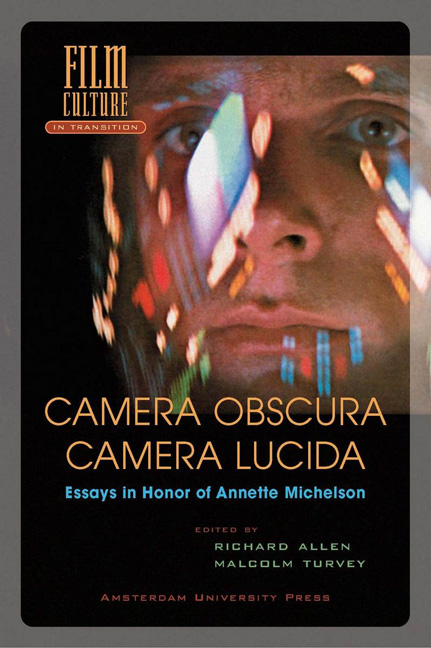Book contents
- Frontmatter
- Contents
- Acknowledgements
- Preface
- Introduction
- The Logic of an Illusion: Notes on the Genealogy of Intellectual Cinema
- Narcissistic Machines and Erotic Prostheses
- Loïe Fuller and the Art of Motion: Body, Light, Electricity and the Origins of Cinema
- Visitings of Awful Promise: The Cinema Seen from Etna
- Transfiguring the Urban Gray: László Moholy-Nagy’s Film Scenario ‘Dynamic of the Metropolis’
- Eisenstein’s Philosophy of Film
- Knight’s Moves
- Hitchcock and Narrative Suspense: Theory and Practice
- From the Air: A Genealogy of Antonioni’s Modernism
- Dr. Strangelove: or: the Apparatus of Nuclear Warfare
- Collection and Recollection: On Film Itineraries and Museum Walks
- Afterward: A Matter of Time: Analog Versus Digital, the Perennial Question of Shifting Technology and Its Implications for an Experimental Filmmaker’s Odyssey
- Select Bibliography
- List of Contributors
- Index
- Film Culture in Transition General Editor: Thomas Elsaesser
Loïe Fuller and the Art of Motion: Body, Light, Electricity and the Origins of Cinema
Published online by Cambridge University Press: 25 January 2021
- Frontmatter
- Contents
- Acknowledgements
- Preface
- Introduction
- The Logic of an Illusion: Notes on the Genealogy of Intellectual Cinema
- Narcissistic Machines and Erotic Prostheses
- Loïe Fuller and the Art of Motion: Body, Light, Electricity and the Origins of Cinema
- Visitings of Awful Promise: The Cinema Seen from Etna
- Transfiguring the Urban Gray: László Moholy-Nagy’s Film Scenario ‘Dynamic of the Metropolis’
- Eisenstein’s Philosophy of Film
- Knight’s Moves
- Hitchcock and Narrative Suspense: Theory and Practice
- From the Air: A Genealogy of Antonioni’s Modernism
- Dr. Strangelove: or: the Apparatus of Nuclear Warfare
- Collection and Recollection: On Film Itineraries and Museum Walks
- Afterward: A Matter of Time: Analog Versus Digital, the Perennial Question of Shifting Technology and Its Implications for an Experimental Filmmaker’s Odyssey
- Select Bibliography
- List of Contributors
- Index
- Film Culture in Transition General Editor: Thomas Elsaesser
Summary
‘O body swayed to music, O brightening glance How can we know the dancer from the dance?’
William Butler Yeats, Among School ChildrenAs we enter the twenty-first century, one of our tasks in recovering the history of cinema in the previous century (and its brief, but crucial, nineteenth century prologue) must be to recover the utopian penumbra cast by cinema's advent. Like the range of new media appearing today, the emergence and transformation of cinema that took place in its first two decades not only introduced new technologies and modes of representation, but also inspired people to think broadly about the way the invention of motion pictures interacted with new ways of conceiving the world and new ways of making art. Roman Jakobson has described how thinking about the cinema in the teens not only inspired the aesthetics of Russian Futurism in its belief that ‘static perception is a fiction’ but also his own critique of the dichotomy of synchrony and diachrony in Saussure's linguistics:
In criticizing this conception, I referred, by no means accidentally, to the example of cinematographic perception. If a spectator is asked a question of synchronic order (for example, ‘What do you see at this instant on the movie screen?’) he will inevitably give a synchronic answer, but not a static one. For at that instance he sees horses running, a clown turning somersaults, a bandit hit by bullets. In other words, these two effective oppositions, synchrony/diachrony and static/dynamic do not coincide in reality. Synchrony contains many a dynamic element, and it is necessary to take this into account when using a synchronic approach.
Writers and thinkers in the early part of the twentieth century proclaimed the cinema, among other things, the first art of the machine, the art form of the twentieth century, and a universal language – all appellations that carried utopian if not millennial overtones. Utopian aspects of the past should never be judged in terms of their realization (or the lack of it), but rather as expressions of broad desires that radiate from the discovery of new horizons of experience. Unrealized aspirations harbor the continued promise of forgotten utopias, an asymptotic vision of artistic, social, and perceptual possibilities.
- Type
- Chapter
- Information
- Camera Obscura, Camera LucidaEssays in Honor of Annette Michelson, pp. 75 - 90Publisher: Amsterdam University PressPrint publication year: 2003
- 1
- Cited by



